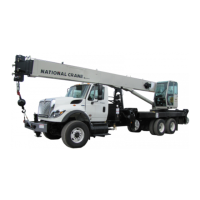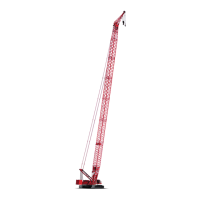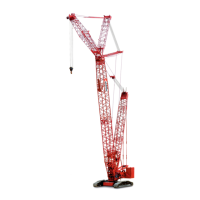Manitowoc Published 03-29-17, Control # 064-23 2-17
14000 OPERATOR MANUAL SAFETY INFORMATION
source. This person should have no other duties while
the crane is working.
6. Taglines should always be made of non-conductive
materials. Any tagline that is wet or dirty can conduct
electricity.
7. DO NOT store materials under power lines or close to
electrical power sources.
8. When operating near transmitter/communication towers
where an electrical charge can be induced into the crane
or load:
• The transmitter must be deenergized OR,
• Tests must be made to determine if an electrical
charge will be induced into the crane or load
• The crane must be provided an electrical ground
• If taglines are used, they must be non-conductive
• Every precaution must be taken to dissipate
induced voltages. Consult with a qualified RF (radio
frequency) Consultant. Also refer to local, state, and
federal codes and regulations
Electrocution Hazard Devices
1. The use of insulated links, insulated boom cages/
guards, proximity warning devices, or mechanical limit
stops does not ensure that electrical contact will not
occur. Even if codes or regulations require the use of
such devices, failure to follow the rules in this section
may result in serious injury or death.
2. Be aware that such devices have limitations and you
should follow the rules and precautions outlined in this
section at all times even if the crane is equipped with
these devices.
3. Insulating links installed into the load line afford limited
protection from electrocution hazards. Links are limited
in their lifting abilities, insulating properties, and other
properties that affect their performance. Moisture, dust,
dirt, oils, and other contaminants can cause a link to
conduct electricity. Due to their capacity ratings, some
links are not effective for large cranes and/or high
voltages/currents.
4. The only protection that may be afforded by an insulated
link is below the link (electrically downstream), provided
the link has been kept clean, free of contamination, has
not been scratched or damaged, and is periodically
tested (just before use) for its dielectric integrity.
5. Boom cages and boom guards afford limited protection
from electrocution hazards. They are designed to cover
only the boom nose and a small portion of the boom.
Performance of boom cages and boom guards is limited
by their physical size, insulating characteristics, and
operating environment (e.g. dust, dirt, moisture, etc.).
The insulating characteristics of these devices can be
compromised if not kept clean, free of contamination,
and undamaged.
6. Proximity sensing and warning devices are available in
different types. Some use boom point (localized)
sensors and others use full boom length sensors. No
warning may be given for components, cables, loads,
and other attachments located outside of the sensing
area. Reliance is placed upon the operator in selecting
and properly setting the sensitivity of these devices.
7. Never rely solely on a device to protect you and your
fellow workers from danger.
Some variables you shall know and understand are:
• Proximity devices are advertised to detect the
existence of electricity and not its distance, quantity,
or magnitude.
• Some proximity devices may detect only alternating
current (AC) and not direct current (DC).
• Some proximity devices detect radio frequency (RF)
energy and others do not.
• Most proximity devices simply provide a signal
(audible, visual, or both) for the operator and this
signal must not be ignored.
• Sometimes the sensing portion of the proximity
devices becomes confused by complex or differing
arrays of power lines and power sources.
8. DO NOT depend on grounding. Grounding of a crane
affords little or no protection from electrical hazards. The
effectiveness of grounding is limited by the size of the
(wire) conductor used, the condition of the ground, the
magnitude of the voltage and current present, and
numerous other factors.
Electrical Contact
If the crane comes in contact with an energized power
source, the operator must:
1. Stay in the crane cab. DON’T PANIC.
2. Immediately warn PERSONNEL in the vicinity to STAY
AWAY.
3. Attempt to move the crane away from the contacted
power source using the crane’s controls which are likely
to remain functional.
4. Stay in the crane until the power company has been
contacted and the power source has been de-energized.
NO ONE shall attempt to come close to the crane or load
until the power has been turned off.
Only as a last resort should an operator attempt to leave
the crane upon contacting a power source. If it is
absolutely necessary to leave the cab, JUMP

